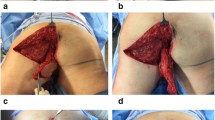Abstract
Background: Morbidity associated with a nonhealing perineal wound is the most common complication following proctectomy, particularly in the setting of recurrent carcinoma of the rectum and radiation therapy. Immediate reconstruction using the gracilis myocutaneous and muscle flaps significantly reduces the incidence of major infection associated with perineal wound closure. The purpose of this study was to assess the value of immediate reconstruction of the perineal wound using a gracilis flap in patients undergoing abdominoperineal resection and intraoperative radiation therapy.
Methods: This study retrospectively reviewed our experience with immediate pelvic reconstruction using gracilis muscle flaps for patients undergoing rectal extirpation and irradiation for recurrent carcinoma of the rectum. From 1990 to 1995, 16 patients underwent abdominoperineal resection (APR) or pelvic exenteration accompanied by immediate wound closure with unilateral or bilateral gracilis muscle flaps. Morbidity and mortality outcomes were compared to those of 24 patients from our institution who, between 1988 and 1992, underwent proctectomy and irradiation for recurrent rectal carcinoma with primary closure of the perineal wound.
Results: Major complications (i.e., major infection requiring hospitalization and/or operation) occurred in 2 (12%) of the patients with gracilis flaps versus 11 (46%) of the patients with primary closure (P = .028 by χ2 analysis for flap vs. primary closure). Minor complications (i.e., persistent sinus and subcutaneous abscess) occurred in 4 (25%) of the patients with gracilis flaps versus 5 (21%) of those with primary closure.
Conclusion: Immediate perineal reconstruction using the gracilis myocutaneous flap following proctectomy and irradiation for recurrent rectal carcinoma significantly reduces the incidence of major infection associated with perineal wound closure.
Similar content being viewed by others
REFERENCES
Tompkins RG, Warshaw AL. Improved management of the perineal wound after proctectomy. Ann Surg 1985;202:760–4.
Anthony JP, Mathes SJ. The recalcitrant perineal wound after rectal extirpation. Arch Surg 1990;125:1372–7.
Kim HK, Jessup JM, Bleday R, et al. Locally advanced rectal carcinoma: pelvic control and morbidity following preoperative radiation therapy, resection, and intraoperative radiation therapy. Int J Radiation Oncology Biol Phys 1997;38:777–83.
Huber FT, Stepan R, Zimmermann F, Fink U, Molls M, Siewert JR. Locally advanced rectal cancer: Resection and intraoperative radiotherapy using the Flab method combined with preoperative or postoperative radiochemotherapy. Dis Colon Rectum 1996;39:774–9.
Delalande JP, Hay JM, Fingerhut A. Perineal wound management after abdominoperineal rectal excision for carcinoma with unsatisfactory hemostasis of gross septic contamination: primary closure vs. packing. Dis Colon Rectum 1994;37:890–6.
Campos RR, Aylon FG, Paricio PP. Management of the perineal wound following abdominoperineal resection: prospective study of three methods. Br J Surg 1992;79:29–31.
Miller LB, Steele G, Cady B, et al. Resection of tumors in irradiated fields with subsequent immediate reconstruction. Arch Surg 1987;122:461–6.
Baird WL, Hester R, Nahai F, et al. Management of perineal wounds following abdominoperineal resection with inferior gluteal flaps. Arch Surg 1990;125:1486–9.
Temple L, Lindsay RL, Temple WJ, et al. Rectus myocutaneous flaps for primary repair for composite resection defects of the pelvis. Perspect Colon Rectal Surg 1993;6:171–6.
Loessin SJ, Meland NB, Devine RM, et al. Management of sacral and perineal defects following abdominoperineal resection and radiation with transpelvic muscle flaps. Dis Colon Rectum 1995;38:940–5.
Bartholdson L, Hulten L. Repair of persistent perineal sinuses by means of a pedicle flap of musculus gracilis. Scand J Plast Reconstr Surg 1975;9:74.
Pezim JE, Wolff BG, Woods JE, et al. Closure of postproctectomy perineal sinus with gracilis muscle flaps. Can J Surg 1987;3:212–4.
Baek SM, Greenstein A, McElhinney AJ, et al. The gracilis myocutaneous flap for persistent perineal sinus after proctocolectomy. Surg Gynecol Obstet 1981;153:713–6.
Woods JE, Beart RW. Reconstruction of nonhealing perineal wounds with gracilis muscle flaps. Ann Plast Surg 1983;11:513–6.
Author information
Authors and Affiliations
Rights and permissions
About this article
Cite this article
Shibata, D., Hyland, W., Busse, P. et al. Immediate Reconstruction of the Perineal Wound With Gracilis Muscle Flaps Following Abdominoperineal Resection and Intraoperative Radiation Therapy for Recurrent Carcinoma of the Rectum. Ann Surg Oncol 6, 33–37 (1999). https://doi.org/10.1007/s10434-999-0033-4
Received:
Accepted:
Issue Date:
DOI: https://doi.org/10.1007/s10434-999-0033-4




